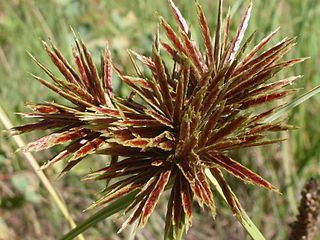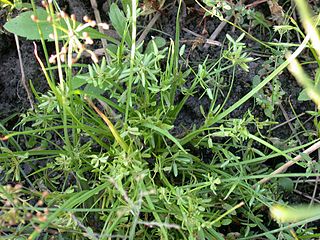
Banksia littoralis, commonly known as the swamp banksia, swamp oak, river banksia or seaside banksia and the western swamp banksia, is a species of tree that is endemic to the south-west of Western Australia. The Noongar peoples know the plant as pungura, boongura or gwangia. It has rough, crumbly bark, linear, more or less serrated leaves arranged in whorls, yellow flowers and up to two hundred follicles in each head.

Cyperus polystachyos, also known as Pycreus polystachyos and commonly known as bunchy sedge, many-spiked sedge, or Texas sedge, is a herbaceous species in the family Cyperaceae, widespread in tropical and subtropical areas around the world, sometimes extending its range into temperate regions. In the United States, it has been reported from a region from Texas to Maine.

Eleocharis is a virtually cosmopolitan genus of 250 or more species of flowering plants in the sedge family, Cyperaceae. The name is derived from the Greek words ἕλειος (heleios), meaning "marsh dweller," and χάρις (charis), meaning "grace." Members of the genus are known commonly as spikerushes or spikesedges. The genus has a geographically cosmopolitan distribution, with centers of diversity in the Amazon Rainforest and adjacent eastern slopes of the South American Andes, northern Australia, eastern North America, California, Southern Africa, and subtropical Asia. The vast majority of Eleocharis species grow in aquatic or mesic habitats from sea level to higher than 5,000 meters in elevation.
Eleocharis atropurpurea is a species of spikesedge known by the common name purple spikerush. This is an aquatic plant native to much of. It also has a wide distribution in temperate regions of North and South America and Asia. It is present in Europe, where it may be an introduced species for the most part.

Eleocharis quinqueflora is a species of spikesedge known by the common names fewflower spikerush and few-flowered spike-rush. It is widespread across Europe, North Africa, northern Asia, and North America. There are also isolated populations in Argentina and Chile.
Persoonia subtilis is a plant in the family Proteaceae and is endemic to south-east Queensland. It is a spreading to low-lying shrub with many stems, branchlets that are hairy when young, linear leaves and yellow flowers in groups of up to eighteen on a rachis up to 50 mm (2.0 in) long.

Eucalyptus tetrodonta, commonly known as Darwin stringybark or messmate, is a species of medium-sized to tall tree that is endemic to northern Australia. It has rough, stringy or fibrous bark on the trunk and branches, lance-shaped leaves arranged in opposite pairs, flowers buds in groups of three, whitish to cream-coloured flowers and cylindrical fruit.

Carex appressa, commonly known as the tall sedge, is a species of flowering plant in the family Cyperaceae, commonly known as sedges.

Hakea linearis is a shrub or tree in the family Proteacea and is endemic to Western Australia. It has smooth branches, mostly linear leaves and white flowers.
Hakea pritzelii is a shrub of the genus Hakea native to a few small areas in the Great Southern region of Western Australia.

Machaerina juncea, commonly known as bare twig-rush or tussock swamp twig rush, is a sedge in the sedge family, Cyperaceae, that is native to Australia, New Zealand, and New Caledonia.

Cyperus congestus, commonly known as dense flat-sedge or clustered flat-sedge, is a sedge of the family Cyperaceae that is native to southern Africa mostly in South Africa, Lesotho and Namibia.

Cyperus flaccidus is a sedge of the family Cyperaceae that is native to Australia.

Cyperus gilesii, commonly known as Giles' flat-sedge, is a sedge of the Cyperaceae that is native to Australia.

Cyperus vaginatus, commonly known as stiff-leaf sedge or stiff flat-sedge, is a sedge of the family Cyperaceae that is native to Australia.
Cyperus victoriensis, also known as channel nut grass is a sedge of the family Cyperaceae that is native to Australia.
Cyperus zollingeri, commonly known as roadside flatsedge, is a sedge of the family Cyperaceae that is native to tropical areas of Australia, Africa and Asia.
Eleocharis acuta, commonly known as common spikerush or small spikerush, is a sedge of the family Cyperaceae that is native to Australia.

Fimbristylis littoralis, commonly known as lesser fimbry or lesser fimbristylis, is a sedge of the family Cyperaceae that is native to many countries in Africa, Asia and Oceania including across much of northern Australia.

Boronia parviflora, commonly known as the swamp boronia, small boronia, tiny boronia, or small-flowered boronia, is a plant in the citrus family Rutaceae and is endemic south-eastern Australia. It is a weak, low shrub with elliptic to egg-shaped leaves with finely toothed edges and up to three pink, white or green four-petalled flowers arranged at or near the ends of the stems.















